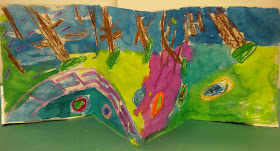
We often make group murals for assemblies, holidays and other special events. Sometimes the kids paint giant backdrops for their individual artwork and sometimes we'll cut their painted paper and work together to reassemble it.



For the annual First Grade Thanksgiving assembly, the students paint huge sheets of paper and we work collaboratively to create big murals for the stage backdrop. I usually borrow one or two to decorate my house for my extended family Thanksgiving. Then, throughout the year I make use of the painted paper for other murals and signs.
 With the 6th graders, we worked on primed canvas with acrylic paints of a limited palette to create a big banner. The students chose one shape and painted a pattern inside. The edge of the banner has the students' hand-prints.
With the 6th graders, we worked on primed canvas with acrylic paints of a limited palette to create a big banner. The students chose one shape and painted a pattern inside. The edge of the banner has the students' hand-prints.












































